Light Emitting Diode (LED)
Introduction
The light-emitting diode is a heavily doped semiconductor device (Theraja and Theraja 456). This means that the size of the depletion layer will be small. The LED is a special type of diode and it is not made by the single semiconductor material. Most diodes are made from basic elements and the most common of these elements include silicon and germanium. A combination of different semiconductor materials is used. The resulting compound that is formed when these materials are combined is used to make the light-emitting diode.
The compounds that are used to fabricate the light-emitting diode include; gallium phosphide (GaP), gallium arsenide (GaAs), gallium arsenide phosphide (GaAsP), gallium indium nitride (GaInN), and Silicon Carbide (SiC) (Holloway and McGuire 65). The light-emitting diodes are mainly used as display devices and they also find applications in indicators. They are used for these purposes since they are more efficient in the use of power. They require little power input while giving a considerable amount of light as the output. They are also not prone to overheating even when they light for a lengthy period.
The diagram below shows a graphical view of a light-emitting diode.
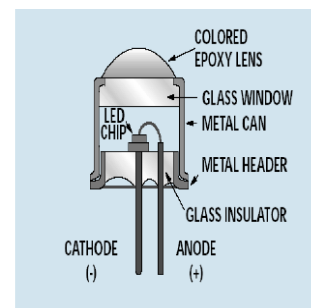
From the figure it can be seen that the LED has a cathode and an anode for the input of power.
Principle of operation
The input power to the LED forward biases the P-N junction within the LED. The forward biasing results in the flow of current through the LED. This reduces the size of the barrier potential that is as a result of the depletion layer (Kelly 263). The reduction of this potential enables electrons to flow. The flow of the electrons is from the conduction band towards the valence band. Once the electrons reach the valence band, they combine with the holes at the valence band. The combination of the two results in the production of energy which is enough to initiate the release of light photons. The thinness of the LED chip ensures that the photons are able to leave the material radiating to produce light.
Current and Voltage through an LED
The current and voltage through an LED can be related using the same equation. The current and voltage in the LED depends on the material used to design the LED. This equation showing the relationship between the current and voltage is shown in equation (i) below:
Where, Id is the LED current, Is is the saturation current, Vd is the LED voltage, Vt is the thermal voltage and N is a constant that is depends on the material that is used to design the LED (Bishop 135).
Color changes
The material that is used to make the LED determines the wavelength of the photons that will be produced (Ferry 145). This in turn determines the color of the light that is produced. The table below shows the materials, their corresponding wavelengths and the light that they will produce.
Table 1.
Uses of LED’s
The LED’s find many applications in our day to day lives. They act as sources of visible and infra-red light. They may also be used as carriers of data over short distances. This can be seen as they are applied in most remote controlled systems. These are also used in vehicles to act as either brake lights, head lights or both (Hassul 412). The LED’s are also used in the traffic lights where a combination of many different LED’s are used to produce the light. They may also be used in displays such ad advertising boards. All these applications are shown in the pictures below:
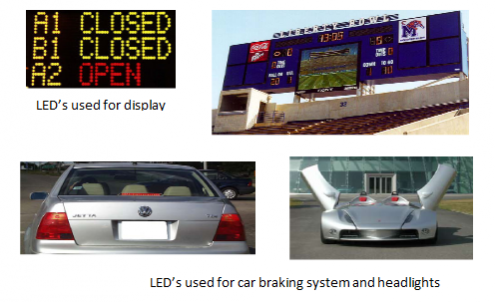
Operation of the LED’s
The LED’s may be operated by either DC supply or an AC supply. When the supply is DC, a current limiting resistor is place in series with the LED to limit the current through the LED to a certain value (Floyd 263). The value of the current limiting resistor can be calculated using Ohm’s law since the value of the input voltage and the current that is required to pass through the LED are known. The value of the forward breakdown voltage of the LED should be obtained from the data books. The LED’s should not be subjected to reverse voltages as this will result in their damage. They are design to operate under forward voltage. They have a threshold reverse voltage which when exceeded results in the breakdown of the LED. The diagram below shows an LED operated from a DC supply.
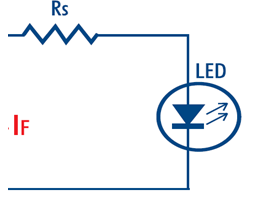
If the operation is from an ac supply, an additional diode may be required to shield the LED from reverse voltages. This will act as a rectifying circuit to allow current to flow only in one direction. The diode therefore emits light during one half-cycle if the connection is as shown in figure A below. This means that the amount of light emitted and the efficiency of the circuit is reduced compared to the case where the source was a DC voltage. If the connection is as shown in figure B, then the diode will be supplied by both the half cycles and the emitted light will be nearly the same as that in the case where a DC source is used.
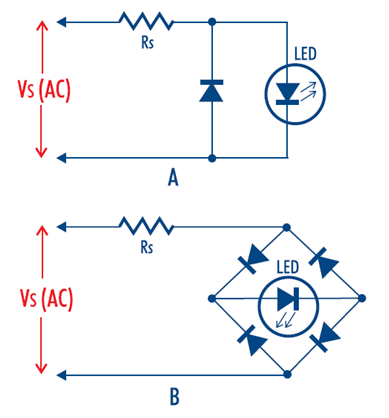
Laser Diodes
Introduction
The LEDs are modified to form laser diodes. The laser diodes are therefore also made of the P-N junction. The depletion layer for the laser diodes is also small. The difference between the construction of a laser diode and the LED is that the region where the flow of current is concentrated is minimized in the case of a laser diode. This means that this region is small for a laser diode while for an LED this region is large (Cathey 155). This is to ensure that the flowing electrons are concentrated within a smaller area. Polishing of the ends of this region is also done. The concentration of holes and electrons in the conduction and valence bands respectively is also made large enough.
This ensures that after recombination, the energy possessed by the photons is so much that their passing can trigger the release of other photons. This clearly shows that the number of photons and therefore light emitted by the laser diode is more compared to that emitted by the LED diode. The stimulation of the production of more photons by the photons that have already been generated is what is referred to as the laser action.
Principle of operation
The laser diode operates in the same way as the LED diode. The only difference is the fact that for a laser diode, there is the laser action where the emitted photons have sufficient energy to stimulate the release of other photons. The recombination of the charge carriers in the conduction and the valence bands takes place like in the case of the LED diode.
Color of the laser
The color of the laser is also determined by the wavelength of the emitted light. The wavelength is determined by the type of material that is used to make the laser. The details concerning these materials are shown in table 1 in the LED section above.
Uses of laser diodes
The laser is mainly used in the compact disk and DVD players. This is because the amount of light that the laser produces is consistent and is also easy to focus on. These players require a high degree of focusing to be able to read and consequently display the required content.
Operation of the laser diode
The laser diode is operated above a certain value of current referred to as the threshold current. Below this value of current, the laser will produce current but will be operating as an LED (Boylestad 541). This means that the light that will be produced will be incoherent. When this value of current is reached, it triggers the laser action and the emitted light will therefore be coherent. The current supplied to the laser also needs to be constant. This means more control mechanisms are required as opposed to when an LED is operated. The control will ensure that the current supplied to the laser is almost constant at all times.
The figure below shows the laser region and the LED region.
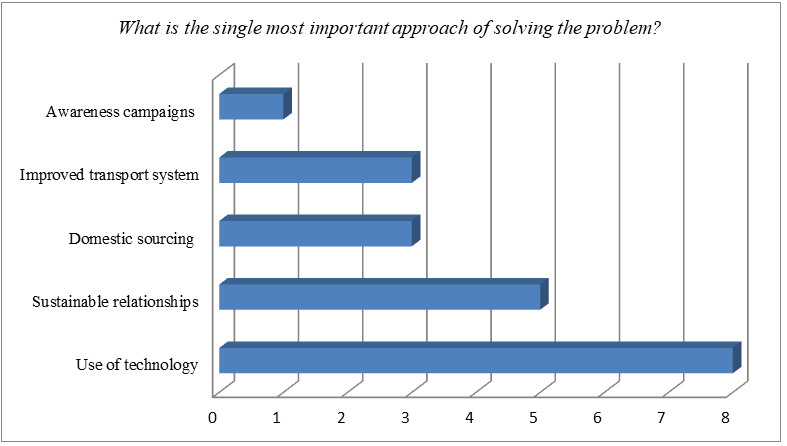
Differences between laser diodes and light-emitting diodes
- The laser diode’s pulse duration is shorter compared to that of the LED’s. This property is mainly used when using the lights emitted by these diodes during optical fiber communication.
- The radiation emitted by the laser diode is not limited while that emitted by the LEDs is limited. This means that the power that is emitted by the laser diodes is much higher.
- The light that is emitted by the LEDs diverges to a greater extent compared to that emitted by the laser diodes.
- The light from a laser diode has a single wavelength while that from an LED is monochromatic.
- The light from a laser diode is from a stimulated emission meaning that all the emitted photons are in phase while that emitted from an LED is from spontaneous emission.
Conclusion
The explanations between the construction of the LED and the laser diodes show some similarities and also some differences. The two are similar in terms of what constitutes them. They may be made from the same compounds but the design in which the layers are laid varies. It is also seen that a laser can operate as an LED if the threshold diode current is not reached. This further shows that these two devices are more similar than they are different. Their applications are however different since the amount and quality of the light they produce varies. The two diodes can therefore not be used interchangeably.
Works Cited
Bishop, Owen. Understand Electronics. Wolgan Valley: Newness, 2001. Print.
Boylestad, Robert L. Electronic Devices and Circuit Theory. Boston: Prentice-Hall, 2009. Print.
Cathey, Jimmie J. Schaum’s Outline of Electronic Devices and Circuits. New York: McGraw-Hill, 2002. Print.
Ferry, David K. Electronic Materials and Devices. London: Academic Press, 2001. Print.
Floyd, Thomas L. Electronic Devices. Boston: Prentice-Hall, 2001. Print.
Hassul, Michael. Electronic Devices and Circuits. Boston: Prentice-Hall, 1997. Print.
Holloway, Paul H and Gary E McGuire. Handbook of Compound Semiconductors. Ohio: William Andrew, 1997. Print.
Kelly, Michael J. Low Dimensional Semiconductors. Oxford: Oxford University Press, 1996. Print.
Theraja, B L and A K Theraja. A Textbook of Electrical Technology. New Delhi: S. Chand & Company LTD, 2005. Print.